
How would you feel if you came across a lake that was bright bubble gum pink in color? Or one that was filled with liquid asphalt? Sounds weird, right? Surprising as it may sound, there are a number of remarkably unusual lakes around the world you wouldn’t believe actually exist. Since lakes are mostly contained ecosystems, they have a great ability to evolve in mysterious and unbelievable ways.
Here we look at some of the most unusual lakes from around the world. Some of these have developed in such bizarre ways that they appear to be products of some sci-fi film.
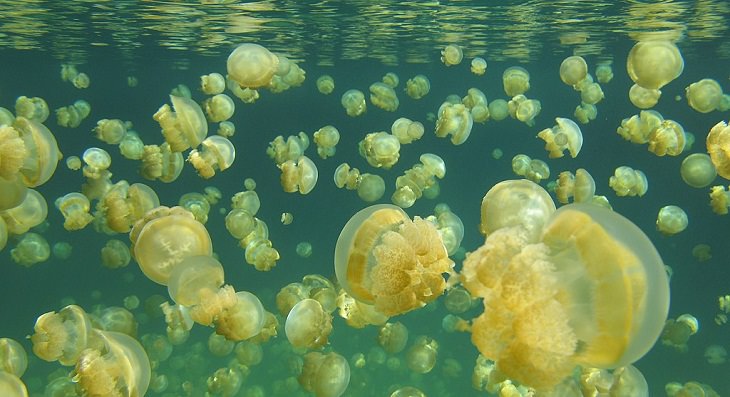
Image source - Wikimedia Commons
Located in Palau, Jellyfish Lake is isolated from the ocean and is a part of the Rock Islands. It is renowned for the remarkably healthy number of golden jellyfish found inside its waters.
Due to its isolation, there is a low population of predators here and the golden jellyfish inside the lake thrive. They feed on algae, and since they have no natural predators to deal with, they keep growing in population and reproduce at an amazing rate. Each day, you will witness swarms of jellyfish migrate from one side of the lake to the other, following the path of the sun and creating a spectacular spectacle.
You can swim in this lake, as golden jellyfish are benign, but you can’t scuba dive as that might disturb the fragile ecosystem.
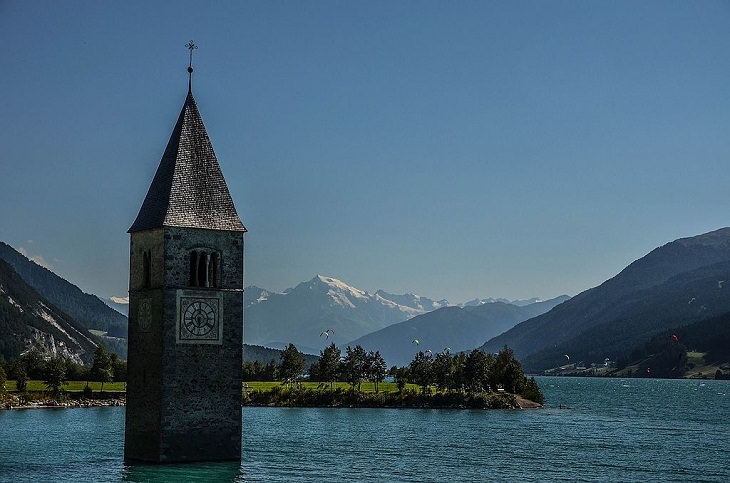
Image source - Wikimedia Commons
The 6 km (3.7 miles) long Resia Lake, located in the north of Italy, is quite fascinating. The unique thing about it, however, is a solitary church steeple emerging half out of its clear waters. The structure is the only visible remnant of a town named Graun (Curon in Italian) that was submerged underwater more than 60 years ago.
A power company then went on to join two natural lakes and create a huge artificial one on the spot. The surrounding towns no longer exist, but the bell tower has managed to survive the trials of time. It is only during winter, when the lake is frozen, that people are able to walk up to the bell tower.
During the summer seasons, the scenery looks surreal and seems to have been lifted from a fantasy film because of the half-submerged church steeple in the Resia Lake. The monument has been declared a protected historical artifact and has become a popular tourist attraction.
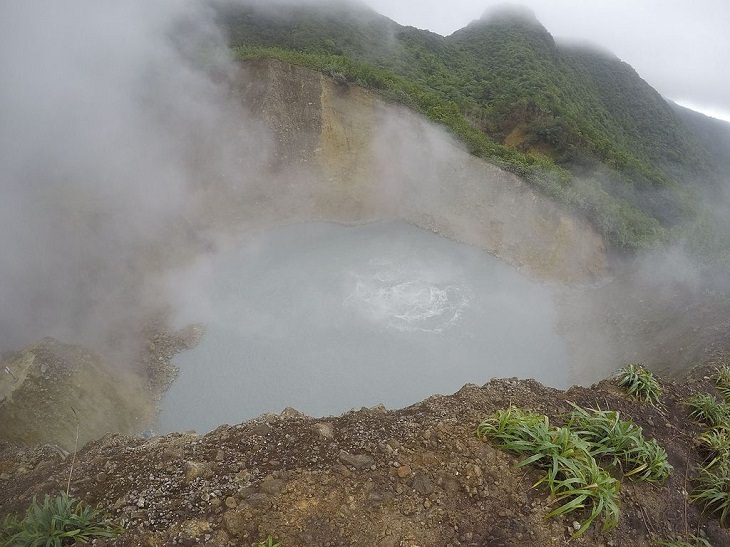
Image source - Wikimedia Commons
This is not a lake where you can go for a swim or surf away merrily. Dominica's Boiling Lake is actually a flooded fumarole from a volcano in the area which is known as the Valley of Desolation. It is in a state of constant boiling point and the water temperature here ranges from 180 to 197 degrees Fahrenheit (82 – 91.5 Celsius) along the edges. The temperature at the center of the lake hasn’t been measured as the water is actively boiling there.
Swirling clouds of vapor always envelope this bizarre lake giving it a resemblance of a cauldron with bubbling greyish-blue water that has been superheated. The steam of gas is generated by an underlying magmatic intrusion that drives water up into the lake. The Boiling Lake was first discovered in 1870 by Mr. Watt and Dr. Nicholls, two Englishmen who were working in Dominica at that time.
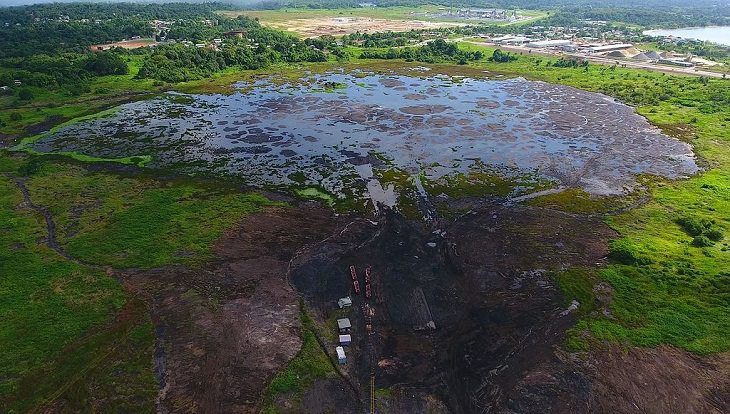
Image source - Wikimedia Commons
Found in southwest Trinidad in the village of La Brea, the Pitch Lake holds about ten million tons of pitch. It is the biggest and most substantial pitch lake in the world and measures approximately one hundred acres (41 hectares) while being 76 meters deep in the center (250 ft). The lake is in a semisolid state and one can actually walk on it. However, the liquid asphalt here is black and viscous.
It is so soft in some areas that one can sink on the surface if they stand on a particular spot for some time. The asphalt does move, although quite slowly. Pitch Lake was created thousands of years ago through the process of subduction. It happened when the Caribbean continental plate was forced under another plate. This resulted in fault lines being opened that let oil from deep underground deposits to rise to the surface where it ended up collecting in a volcanic crater.
The air then triggered components of the oil to evaporate and left behind the heavy asphalt, a mix of oil, clay, and water.
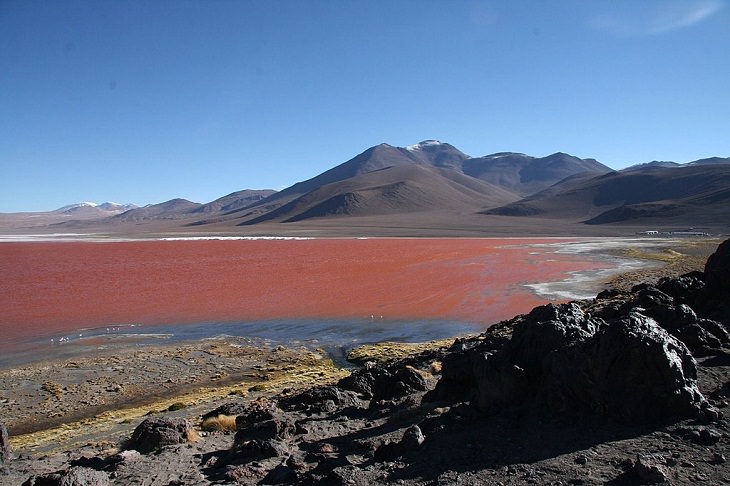
Image source - Wikimedia Commons
Laguna Colorada, also known as the Red Lagoon, stands out immediately because of its red-colored water and upon first glance almost looks like some piece of a Martian landscape. This is, in fact, a shallow salt lake that is tinged with red algae and other microorganisms that thrive in the water. Located in Bolivia at an altitude of 14,000 feet, this salt lake is speckled with large white pools that are caused by huge borax deposits on its surface.
The stark red color of the lake lies in perfect contrast to the rolling mountains and rugged rocky shores that surround it. Laguna Colorada is also home to a rare breed of flamingo called the puna flamingo that throng the shores in hordes all year-round.
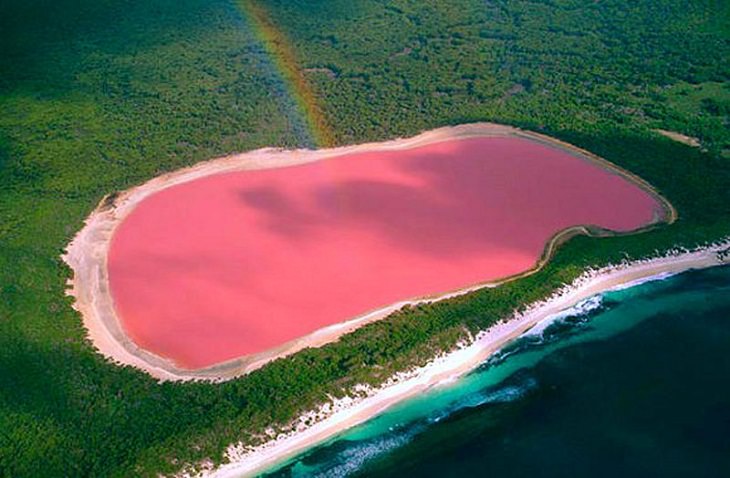
Image source - Wikimedia Commons
Lake Hillier in Australia is famous because of its distinctive bubblegum or strawberry milkshake color. While the exact cause of its peculiar color has not been ascertained, most scientists believe that it is probably because of the presence of a specific species of microalgae called Dunaliella Salina in it. These organisms are said to produce beta-carotene that apparently gives rise to the lake’s colored water. However, unlike other pink lakes that regularly change colors, Lake Hillier maintains its pink shade all through the year.
Swimming in the lake isn’t possible anyway as the island is used only for research purposes and you can only admire it from a helicopter. A belt of white salt and eucalyptus evergreen forest surrounds the lake, which enhances its unique beauty.
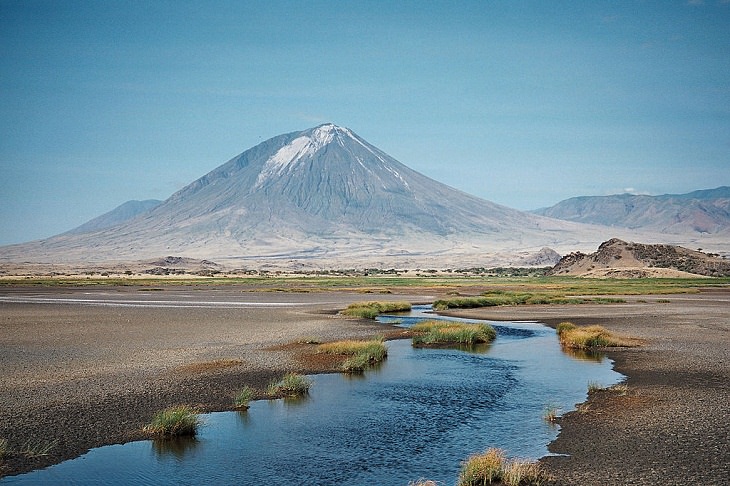
Image source - Wikimedia Commons
From the outside, Lake Natron looks like any other serene little lake. However, what goes on inside its waters can give source material to several horror films.
Located in northern Tanzania, Lake Natron is a salt lake where water flows in but doesn’t flow out. The alkaline water in the lake has a pH content that is as high as 10.5 and it can be so caustic that it often burns skin and eyes of animals that haven’t adapted to it. The water’s alkalinity is produced by the sodium carbonate and other minerals that flow into the lake from the hills nearby.
A few years back, a photographer had captured ghastly images of a calcified flamingo, a bat, an eagle, and a swallow, among other creatures, that he found during his visit to the spot. Nobody knows for certain how the animals die there but some researchers have deduced that the water’s sodium carbonate content helps in preserving the bodies of those animals who were unfortunate enough to die in the lake.
Interestingly, Lake Natron's alkaline waters also support a flourishing ecosystem of salt marshes, freshwater wetlands, flamingos, and other wetland birds, as well as tilapia and the algae.
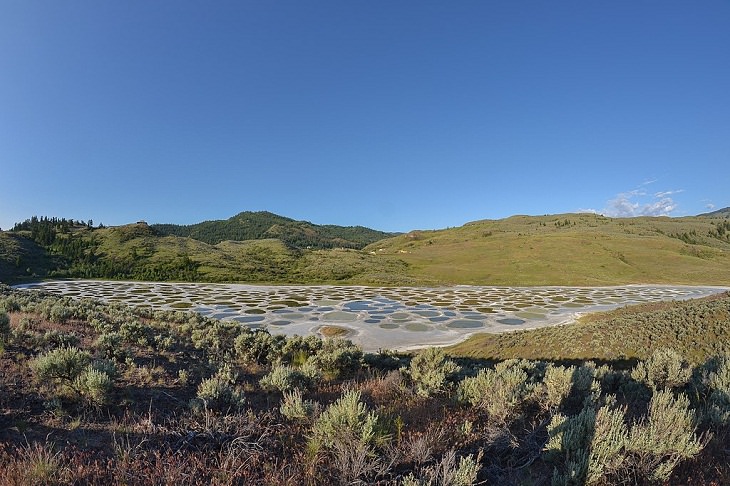
Image source - Wikimedia Commons
The Spotted Lake, or Kliluk, is an oddly-patterned water body that is located in British Columbia’s desert. The lake consists of great amounts of magnesium sulfate, calcium, and sodium sulfates, as well as silver and titanium. In the summer season, when the water begins to evaporate from the lake, the minerals in the water harden and are revealed as yellow, green, and blue spots. You can actually see the salt crystal polka dots, which look to have appeared from some strange alien planet. Curiously, these salts from Kliluk were used in the manufacturing of ammunition in World War I.
Another fascinating feature of this spot is that the lake has been considered a sacred place for centuries by the natives of the Okanagan Nation. The people believed that the different spots on the water have healing and medicinal properties.